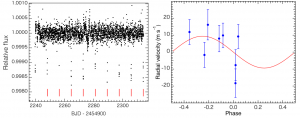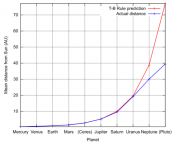Title: The K2-ESPRINT Project VI: K2-105 b, a Hot-Neptune around a Metal-rich G-dwarf
Authors: N.Narita et al. 2017
First Author’s Institution: Department of Astronomy, The University of Tokyo, 7-3-1 Hongo, Bunkyo-ku, Tokyo 113-0033, Japan
Status: Accepted in the Publications of the Astronomical Society of Japan, open access
At the end of its extended 4 year campaign in space, Kepler scientists were left with a telescope that despite certain limitations, could still do good science. Thus the K2 mission was born and has so far found an additional 520 candidate exoplanets, including K2:105 b: a “Hot-Neptune” orbiting around a Sun-like G2 star. In this astrobite we will be discussing the K2 mission, confirming candidate planets using ground based telescopes and the importance of objects like K2-105 b if we are ever going to understand our own Solar system.

Fig 1: The observation fields for Kepler, including Field 5 which contains K2-105b. Credit: Kepler mission, NASA.
Launched in 2009, Kepler spent four years watching hundreds of thousands of stars in order to catch transiting exoplanets. When a planet moves in front of its host, a characteristic dip in brightness is observed which is related to the radius of the exoplanet. The mission almost came to an end when the second of Kepler’s four reaction wheels ceased operations limiting control over its orientation. Thankfully the clever scientists at NASA concluded that Kepler could still be manoeuvred sufficiently to observe stars in one patch of the sky for 80 days. This gave rise to the K2 mission and provided scientists with a chance to continue their hunt for new planets.
As of December the 21st 2016, the number of confirmed exoplanets sits at a staggering 3,439 planets, with some existing inside 576 confirmed planetary systems. Yet with over a thousand potential Kepler planets there is clearly still a lot of work to do on the ground. Kepler candidate planets are often confirmed through follow up observations of a stars wobble – this is known as the radial velocity method and when combined with transit data reveals the mass of an exoplanet.

Fig 2: (Left. Fig.1 of paper) Light curve of K2-105 taken by Kepler, with red bars to indicate the positions of transits, required to determine the radius of K2-105 b. (Right. Fig.6 of paper) Radial velocity data, taken with the Subaru telescope based in Hawaii, is combined with transit data to estimate the mass of K2-105 b.
With a Neptune-like radius of around 23,000 km and orbital period of 8.27 days around its Sun-like host, K2-105 b is described as a Hot-Neptune. Hot-Neptunes are Neptune-sized planets with a radius between 3-6 times that of the Earth which orbit close to their star. Previous studies have only uncovered a few Hot-Neptunes around solar mass stars, and no exoplanets larger than Hot-Neptunes around smaller stars. This has lead some scientists to hypothesise the existence of a size boundary which planets must exceed to become a gas giant like Jupiter – meaning future investigation of Hot-Neptunes like K2-105 b are vital to understanding the formation of our outer Solar system.
One major aspect for further study is uncovering the mass of K2-105 b. Some parameters were not extracted from the original radial velocity data, meaning current mass estimates are poorly constrained at 30 +/- 19 Earth masses. If the total mass is fewer than 30 Earth masses, scientists believe that the planet is likely to be a rocky planet with around 10% of its mass existing as an atmosphere – a kind of gas dwarf planet. This conclusion just leads to more questions such as how does a gas dwarf form? All current formation scenarios require the planetary mass to be known and this requires more radial velocity data.
Observations of Hot-Neptunes could provide a good insight into the early days of Solar system formation. Clearly we have no K2-105 bs in our Solar system, and our own icy giants, Neptune and Uranus, are located beyond 20 AU. During the formation of a planetary system, planets are believed to migrate inwards towards their host star. The ‘Nice’ model suggests Saturn and Jupiter migrated inwards and not only acted as a barrier for icy giant inward migration, but also pushed Neptune and Uranus outwards to a highly elliptical orbit. Continued radial velocity observations will not only help constrain the mass of K2-105 b, but will also confirm whether the exoplanet has company in the form of outer planets.
The Kepler spacecraft has discovered and confirmed thousands of exoplanets since its launch, providing scientists with new insights into just how odd and unique our own Solar system is. Hopefully K2-105 b is just the start of a Hot-Neptune discovering extravaganza required to uncover its early secrets.





Why do you put quote marks around “Nice” (the name of the city in which the model was proposed)?